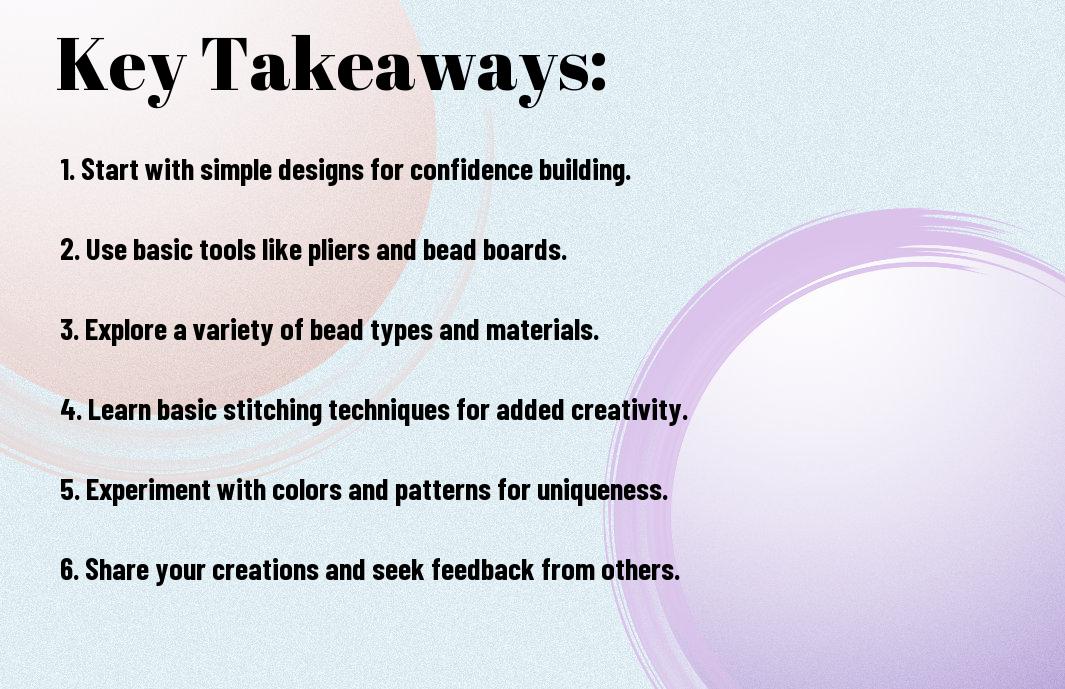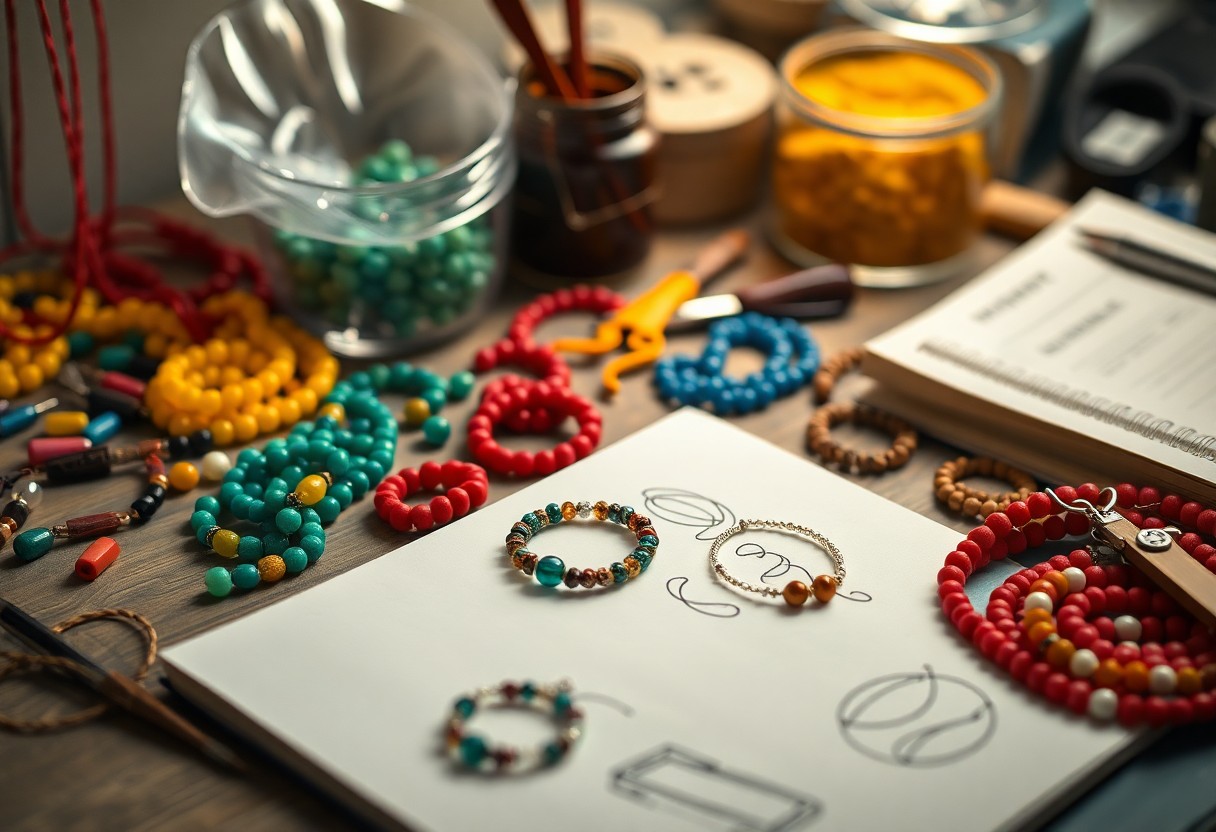Key Takeaways:
- For beginners, it’s best to start with simple beading projects that require minimal materials and techniques, such as making a bracelet or a pair of earrings.
- Practice is key to improving beading skills, and starting with small projects allows beginners to develop their techniques and build confidence before moving on to more complex projects.
- Using online tutorials and beading patterns can be extremely helpful for beginners, as they provide step-by-step instructions and visual guidance to ensure that the project turns out as expected.
Getting Started
The world of beading is exciting and creative, and as a beginner, you’re about to initiate on a journey that will bring you joy and fulfillment. You’ll discover the basics of beading and learn how to create beautiful pieces that reflect your personal style.
Choosing the Right Beads
With so many types of beads available, you’ll want to select the ones that suit your project and skill level. You’ll find that different beads have unique characteristics, and choosing the right ones will make your project more enjoyable and successful.
Essential Tools for Beginners
To get started with beading, you’ll need a few basic tools that will make the process easier and more efficient. You’ll need a good pair of scissors, a beading needle, and a beading board, which will help you organize your beads and threads.
Beads are just the beginning, and having the right tools will help you to handle and manipulate them with ease. As you progress in your beading journey, you’ll find that investing in good quality tools will save you time and frustration, allowing you to focus on creating beautiful and intricate designs that reflect your unique style and creativity, and you will be able to make the most of your beading experience.

Basic Beading Techniques
If you’re new to beading, it’s imperative to start with the fundamentals. You’ll need to learn various techniques to create beautiful pieces, and with practice, you’ll develop your skills and confidence.
Stringing and Threading
Upon beginning your beading journey, you’ll discover that stringing and threading are basic techniques. You’ll learn to navigate beads onto a thread or wire, creating a foundation for your projects, and as you practice, you’ll find it becomes second nature.
Knotting and Weaving
Woven into the fabric of beading, knotting and weaving are techniques that add texture and visual interest. You’ll use these methods to secure beads, create patterns, and add depth to your designs, allowing you to express your creativity.
For instance, as you master knotting and weaving, you’ll be able to create intricate patterns and designs, and you’ll find that your beading projects take on a new level of sophistication, allowing you to personalize your jewelry and make it truly unique, reflecting your style and flair.

Popular Beading Projects
Your introduction to beading can be exciting and creative, with various projects to choose from, allowing you to explore different techniques and styles, and find what suits you best.
Simple Jewelry Making
Around the world of beading, you’ll find that making simple jewelry is a great way to start, as it requires minimal materials and tools, and you can create beautiful pieces to wear or gift, enhancing your skills and confidence.
Decorative Items for the Home
Beading can also be used to create stunning decorative items for your home, such as beaded curtains, ornaments, and wall hangings, which can add a personal touch and unique style to your space, showcasing your creativity.
Due to the versatility of beading, you can create a wide range of decorative items that reflect your personal taste and style, from elegant and sophisticated to playful and whimsical, allowing you to express yourself and add a personal touch to your home decor, making it truly special and meaningful to you.
Bead Types and Materials
For your beading projects, you’ll encounter various materials. Consider:
- Seed beads
- Gemstones
| Type | Description |
|---|---|
| Seed Beads | Small, uniform beads |
| Gemstones | Natural, colorful stones |
| Crystal | Sparkling, faceted beads |
| Metal | Durable, versatile beads |
| Wood | Natural, earthy beads |
Recognizing your options will help you choose the best beads for your projects.
Seed Beads and Gemstones
Above all, after selecting your beads, you’ll find seed beads and gemstones are popular choices, offering a range of colors and textures to enhance your designs.
Shaping and Coloring Beads
Beside the type of bead, you’ll also consider shaping and coloring, which can greatly impact the overall look of your beading project, allowing you to add unique touches and personality.
Types of shaping and coloring techniques include etching, painting, and applying finishes, allowing you to customize your beads and create distinctive, one-of-a-kind pieces that reflect your style and creativity, as you work with different materials and explore various methods to achieve the desired effects for your beading projects.
Tips and Tricks
Not every beading project will turn out as expected, but with practice, you’ll improve. Some tips to keep in mind:
- Use good quality beads
- Follow patterns carefully
The key to success lies in patience and attention to detail.
Avoiding Common Mistakes
These are common pitfalls that you should be aware of when starting your beading journey. You can avoid mistakes by double-checking your work and using the right tools.
Enhancing Your Beading Skills
For you to become proficient in beading, practice is vital. You’ll develop your skills and style with time and experience, allowing you to take on more complex projects.
This skill enhancement process involves trying new techniques, experimenting with different materials, and learning from your mistakes. As you progress, you’ll find that your beading skills improve, and you’ll be able to create more intricate and beautiful pieces, reflecting your unique personal style and flair, which will make your beading journey even more enjoyable and rewarding for you.
Beading Community and Resources
Keep in mind that as a beginner, you’ll need guidance and support to improve your beading skills. You’ll find numerous online resources, beading communities, and local classes that can help you learn and grow as a beader.
Online Forums and Tutorials
Besides the wealth of information available online, you can join forums and watch tutorials to learn new techniques and get inspired by other beaders’ projects. You can find tutorials on various platforms, including YouTube and craft websites.
Local Beading Classes and Workshops
Before you start beading, consider taking a local class or workshop to get hands-on experience and feedback from an instructor. You’ll learn from experienced beaders and get to practice your skills in a supportive environment.
Tutorials and hands-on practice will help you master various beading techniques, and local classes will give you the opportunity to network with other beaders, learn about new trends, and get feedback on your projects, helping you to improve your skills and build your confidence as a beader.
To wrap up
Considering all points, you now have a solid foundation to start your beading journey. You can explore various techniques and projects, from simple jewelry to complex designs, to enhance your skills. As you progress, your creations will reflect your unique style, and you’ll be able to showcase your artistic side through your beading projects, taking your hobby to the next level with practice and patience, and making the most of your newfound hobby.
FAQ
Q: What are the best beading projects for beginners to start with?
A: The best beading projects for beginners include simple jewelry making projects such as a basic beaded necklace, earrings, and bracelets. These projects require minimal materials and techniques, making them perfect for those new to beading. Some popular projects for beginners include a single-strand bead necklace, a pair of beaded earrings, and a simple beaded cuff. These projects are great for practicing basic beading skills and building confidence in your abilities.
Q: What materials do I need to get started with beading?
A: To get started with beading, you will need a few basic materials, including beads, beading thread or wire, scissors, and a clasp. You may also want to invest in a beading board, beading needles, and a pair of beading pliers. The type of beads and thread you choose will depend on the specific project you want to make. For example, if you are making a seed bead project, you will need seed beads and a beading needle, while a wire working project will require wire and wire cutters.
Q: What are some common beading techniques that beginners should learn?
A: There are several common beading techniques that beginners should learn, including stringing, wire working, and weaving. Stringing involves threading beads onto a length of thread or wire, while wire working involves shaping and forming wire into various shapes and designs. Weaving involves using a needle and thread to weave beads into a fabric-like texture. These techniques are the foundation of most beading projects and are necessary for creating beautiful and professional-looking jewelry.
Q: How do I choose the right beads for my beading project?
A: Choosing the right beads for your beading project involves considering several factors, including the color, shape, size, and material of the beads. You should also consider the theme and style of the project, as well as the level of difficulty. For example, if you are making a delicate, elegant necklace, you may want to choose small, shimmering beads, while a bold, statement piece may call for larger, more dramatic beads. It’s also important to choose beads that are compatible with the type of thread or wire you are using.
Q: What are some tips for improving my beading skills and avoiding common mistakes?
A: To improve your beading skills and avoid common mistakes, it’s a good idea to start with simple projects and gradually work your way up to more complex ones. You should also practice regularly to develop your skills and build your confidence. Additionally, make sure to follow patterns and instructions carefully, and don’t be afraid to experiment and try new things. It’s also a good idea to join a beading community or take a class to learn from experienced beaders and get feedback on your work. By following these tips, you can improve your beading skills and create beautiful, professional-looking jewelry.

